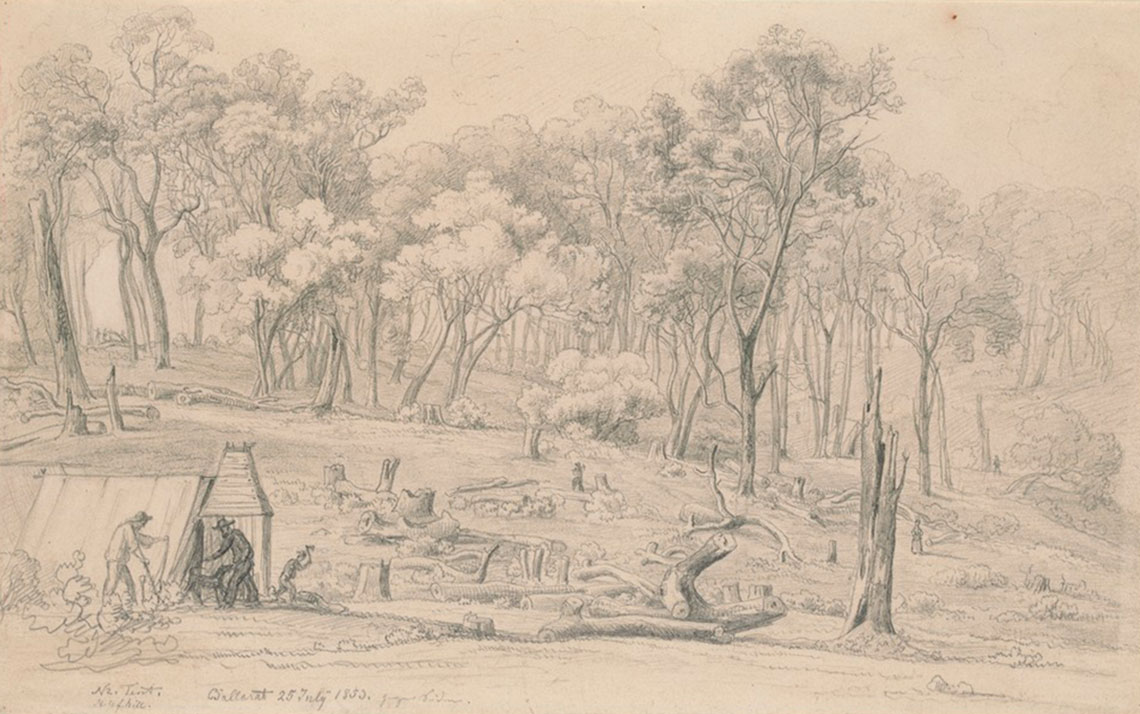
Ballarat July 1853, Eugene von Guerard.
IMAGE COURTESY OF THE STATE LIBRARY VICTORIA, H12535.
Ballarat is a picturesque city. It is known for its ornate buildings and wide boulevards, well-manicured streetscapes and rich goldrush and Aboriginal cultural heritage. The town was changed drastically by the discovery of gold in 1851. Gold sparked an influx of fortune seekers from all corners of the globe, who believed it would bring them a better life and a more secure future. It is estimated that between 1851 and 1870, almost 10 million ounces of gold was found in Ballarat.1
The early years of the goldrush were a period of great tension and turmoil. Friction between miners and the military had been building for months because of the licensing system, which miners felt was unfair. On the morning of Sunday 3 December 1854, this tension culminated in an event with national implications, known as the Eureka Stockade. The miners lost the battle at Eureka, but their actions led to what some historians claim as the start of democracy in Australia, with miners later winning the right to vote.2
As the turmoil of the Eureka Stockade subsided, the city of Ballarat started to take shape. Permanent buildings began to replace temporary ones. A hospital was constructed, as well as a benevolent asylum and mechanics institute.
Churches and schools were established as communities laid down their roots.3 A year after the Eureka Stockade, in 1855, Ballarat borough was proclaimed. It was then that the land on the south west corner of Sturt and Armstrong streets was reserved for the future town hall.4
Almost immediately, a temporary wooden hall and council chambers were built, as well as a small two-roomed messenger’s cottage. But in September 1859, disaster struck. A fire broke out in a warehouse next door. It quickly engulfed the warehouse as police and bystanders frantically tried to save the surrounding buildings. It was soon discovered that the keys to a nearby water supply were locked inside the council chambers, a wooden structure which stood where you are now, and which was itself under threat of fire. Without a water supply, rescue efforts were futile. The fire burned so quickly that within ten minutes of the first call of ‘Fire!’, the council chambers were ablaze. The town clerk and town inspector rushed into the building to retrieve plans, papers and furniture. By the time the fire brigade arrived, almost an hour later, the building was in ashes.5
REFERENCES
[1] ‘Ballarat City’, Victorian Places, http://www.victorianplaces.com.au/ballarat-city, accessed 12 June 2018.
[2] ‘Eureka Stockade’, ergo, State Library Victoria, http://ergo.slv.vic.gov.au/explore-history/golden-victoria/impact-society/eureka-stockade, accessed 12 June 2018; ‘Eureka Stockade’, National Museum Australia, http://www.nma.gov.au/online_features/defining_moments/featured/eureka_stockade, accessed 12 June 2018.
[3] ‘Ballarat City’, Victorian Places, http://www.victorianplaces.com.au/ballarat-city, accessed 12 June 2018.
[4] Lovell, 1995, p. 5.
[5] The Star, 26 September 1859, p. 3.